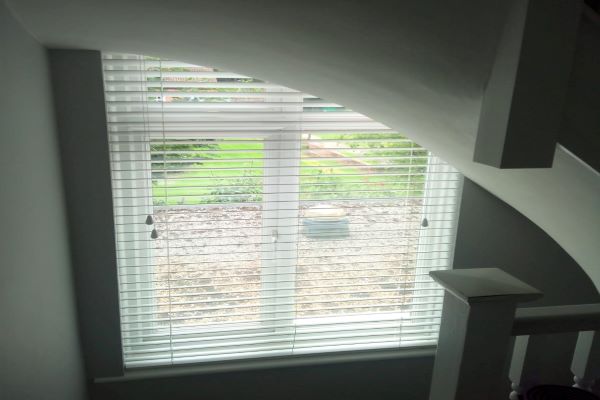Venetian Blinds vs. Vertical Blinds: Which is Right for My Home?

June 29, 2022
At first glance you may think that Venetian Blinds and Vertical Blinds are interchangeable. Both types are easily recognisable as being constructed from slats or louvres which can be tilted to control light and privacy levels within the home.
Venetian Blinds have shorter and narrower horizonal slats, tightly spaced with full tilt or raise/lower control via a control rod you twist or by the use of two cords you pull gently – tilting in either direction. Venetian Blinds are usually made from wood, faux-wood or aluminium materials.
As the name quite rightly suggests; Vertical Blinds are crafted with longer vertical slats or louvres instead and are made of fabric, weighted at the bottom and sometimes connected by chains. Yet, these two stylistically similar blinds can serve vastly different purposes within the home.
Read on to find out more about Venetian Blinds vs. Vertical Blinds in this week’s blog from your local custom blinds industry expert – Blind Technique.
Venetian Blinds vs. Vertical Blinds – window size
Smaller windows such as those in an office, study, bathroom or kitchen may benefit from Venetian Blinds. You can flex the light control from tilt function to fully open using the cord to achieve maximum daylight within the room. If privacy is a priority in this space, then simply pull the cord or wand to close the louvres to completely flush within their frame in an instant. Smaller slats can offer a sense of space in the room, especially as Venetian Blinds sit compactly against your window frame once installed and you also still retain the use of your window sill.
Vertical Blinds are more suited to larger windows where the longer, weighted slats/louvres hang perfectly within the space to operate more freely on their track when open or closed – to the left, to the right or split open to both sides like a pair of curtains would. Vertical Blinds can be seen to hang more dominantly in the window frame and can take up a proportion of your window sill due to their construction – so more suited to larger windows and openings where the sills are not in daily use like those for patio doors and floor to ceiling windows or for offices or commercial corridors. Even when fully retracted they can also obscure some of the window opening – like curtains can.
Venetian Blinds vs. Vertical Blinds – usage frequency
Venetian Blinds open and close in seconds with the pull of a cord – similar to the instant operation of Roller Blinds, for example. They are usually made from a robust material so they can easily withstand years of daily usage. Cords are kept out of reach of children so they are less likely to experience accidental damage.
Vertical Blinds are weighted and these days are mostly free hanging, doing away with the old-fashioned chains at the bottom of each individual slat/louvre. When installed in windows the louvres are at hand height, resting on the window sill – which can make them tempting for young children to discover as they are in easy reach. The actual daily operation of Vertical Blinds, however, can be performed using a child safe wand.
Venetian Blinds vs. Vertical Blinds – making a design statement
Venetian Blinds are a non-fabric blind so they tend to make a timeless and classic design statement once installed – we have almost 100 different colours and finishes to browse which never date. Our range of Vertical Blinds here at Blind Technique means there are over 300 fabrics to choose from to create your custom-made favourite colour, pattern and style from traditional to modern and contemporary.
Venetian Blinds vs. Vertical Blinds – ease of cleaning and maintenance
The vertical arrangement of the slats/louvres in Vertical Blinds means that they do not collect dust in the same way as Venetian Blinds do (just wipe with a damp cloth) and the fabrics used to craft them as usually machine washable. Always operate both blinds gently so as not to snag the slat/louvre arrangement so they continue to hang perfectly straight once installed.
Venetian Blinds vs. Vertical Blinds – budget-conscious decisions
Non-fabric blinds such as Venetian Blinds can be thought of more as an investment although the aluminium or faux-wood versions can also be viewed as budget-friendly choices. Vertical Blinds are renowned to be a great value product to achieve a cost effective window dressing solution for domestic or commercial purposes. If you choose to opt for manual operation as opposed to motorisation you can see more flexibility in the competitive prices offered by Blind Technique.
As ever, the winner when it comes to deciding between Venetian Blinds vs. Vertical Blinds is up to you, the customer.
If you would like to arrange a FREE Home Appointment for one of our friendly and professional advisors to attend your home and advise further on the Venetian Blinds vs. Vertical Blinds debate, call us today.



